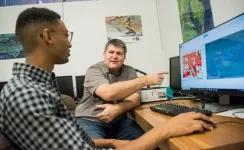(Press-News.org) An international research team led by QuTech has demonstrated a network connection between quantum processors over metropolitan distances. Their result marks a key advance from early research networks in the lab towards a future quantum internet. The team developed fully independently operating nodes and integrated these with deployed optical internet fibre, enabling a 25 km quantum link. The researchers published their findings in Science Advances.
The internet allows people to share information (bits) globally. A future quantum internet will enable sharing quantum information (qubits) over a new type of network. Such qubits can not only take the values 0 or 1, but also superpositions of those (0 and 1 at the same time). In addition, qubits can be entangled, which means they share a quantum connection enabling instant correlations, no matter the distance.
Researchers around the globe are working to build quantum networks that make use of these features to offer fundamentally new communication and computing capabilities, in coexistence with the current internet. For example, qubits can generate secure encryption keys for safely sharing financial or medical data. Quantum links can also connect distant quantum computers, enhancing their power and allowing access with full privacy for users.
Moving out of the lab
An international team led by Ronald Hanson at QuTech—a collaboration between the TU Delft and TNO—was able to connect two small quantum computers between the Dutch cities of Delft and The Hague. “The distance over which we create quantum entanglement in this project, via 25 km of deployed underground fiber, is a record for quantum processors,” says Hanson. “This is the first time such quantum processors in different cities are connected.”
A few years ago the team reported the first multi-node quantum network inside the lab. “We were faced with new major challenges in going from these lab experiments to realizing a quantum link between cities. We had to design a flexible system that lets the nodes work independently over long distances, we needed to mitigate the impact of photon loss on the connection speed, and we had to ensure reliable confirmation each time the entanglement link was successfully created. Without these innovations, such a large distance would not have been possible.”
‘Like keeping the moon at a constant distance’
To tackle the challenge of photon loss, the team established the quantum connection using a photon-efficient protocol that required very precise stabilization of the connecting fiber link. Co-author Arian Stolk explains using an analogue: “The link needed to be stable well within the wavelength of the photons (smaller than a micrometer) over 25 kilometer of optical fiber. That challenge compares to keeping the distance between the earth and the moon constant with the accuracy of only a few millimeter. Through a combination of research insights and applied engineering, we were able to solve this puzzle.”
“In this work, we demonstrate successful entanglement between two quantum network nodes containing diamond spin qubits. The independently operated nodes are connected through a midpoint station via optical fiber. We were able to reliably deliver a pre-specified entangled state between the nodes.”
Collaboration between academia and industry
Co-author Kian van der Enden explains how indispensable the broad expertise of the team was for the success of the project: “Fraunhofer ILT developed a critical component for this demonstration, a new type of quantum frequency converter. OPNT delivered state-of-the-art timing hardware, Element Six provided its engineered synthetic diamond materials and Toptica developed high-stability lasers. Finally, Dutch telecom provider KPN provided the fiber infrastructure as well as the locations of the nodes, the midpoint, and the node in The Hague.”
Solid foundation for European quantum internet
This result is an important milestone that addresses key scaling challenges for future quantum networks. Jesse Robbers, Director Industry & Digital Infrastructure of Quantum Delta NL that co-funded the research, adds: “We continue to show leadership in the development of the future fundament of our Digital Infrastructure and how to make it applicable, which is the core of the national and European strategy.”
The architecture and methods are directly applicable to other qubit platforms, including the next-generation scalable qubits that the team is currently developing. The successful use of deployed, conventional internet infrastructure sets the stage for a new phase on the road towards a quantum internet. Hanson: “This work marks the crucial step out of the research lab into the field, enabling exploration of first quantum processor networks at metropolitan scale.”
END
A rudimentary quantum network link between Dutch cities
Stepping out of the lab, into the real world, towards a European quantum internet
2024-10-30
ELSE PRESS RELEASES FROM THIS DATE:
Accounting for bias in medical data helps prevent AI from amplifying racial disparity
2024-10-30
Black patients are less likely than white patients to receive medical tests that doctors use to diagnose severe disease, such as sepsis, researchers at the University of Michigan have shown.
Because of the bias, some sick Black patients are assumed to be healthy in data used to train AI, and the resulting models likely underestimate illness in Black patients. But that doesn't mean the data is unusable—the same group developed a way to correct for this bias in data sets used to train AI.
These new insights are reported in a pair of studies: one published ...
MD Anderson Research Highlights for October 30, 2024
2024-10-30
HOUSTON ― The University of Texas MD Anderson Cancer Center’s Research Highlights showcases the latest breakthroughs in cancer care, research and prevention. These advances are made possible through seamless collaboration between MD Anderson’s world-leading clinicians and scientists, bringing discoveries from the lab to the clinic and back.
Epigenetic targets and genomic stem cell pathways drive adult hair regeneration
Retrotransposons are interspersed repeating sequences that make up over 40% of the human genome. Proper tissue regeneration requires ...
Three Baycrest leaders named 2024 Canada’s Most Powerful Women: WXN’s Top 100 Award winners
2024-10-30
Toronto, ON, October 30, 2024 – Three Baycrest leaders are among those named winners of Women Executive Network’s (WXN) prestigious 2024 Canada’s Most Powerful Women: Top 100 Awards, celebrating exceptional leadership and groundbreaking achievements that have meaningfully transformed their industries, companies, communities and country.
Dr. Allison Sekuler, President and Chief Scientist, Baycrest Academy for Research and Education and President and Chief Scientist, Centre for Aging + Brain Health Innovation, powered by Baycrest (CABHI)
Dr. ...
Scientists uncover new mechanism in plant cold sensing
2024-10-30
Cold damage is a major challenge in rice production, and identifying key gene modules in signaling pathways is a crucial means of addressing this issue. A Chinese research team has recently discovered a part of the plant’s cell membrane that helps plants sense when it's cold.
This cell membrane component, known as the COLD6-OSM1 module, triggers the production of a special molecule, 2',3'-cAMP, which helps plants sense and respond to low temperatures. This secondary messenger is a key upstream component that mediates the signaling pathway by directly responding to signals ...
Study shows natural regrowth of tropical forests has immense potential to address environmental concerns
2024-10-30
A new study in Nature finds that up to 215 million hectares of land (an area larger than Mexico) in humid tropical regions around the world has the potential to naturally regrow. That much forest could store 23.4 gigatons of carbon over 30 years and also have a significant impact on concerns like biodiversity loss and water quality. The study showed that more than half of the area with strong potential for regrowth was in five countries: Brazil, Mexico, Indonesia, China, and Colombia.
“Tree planting in degraded landscapes can be costly. By leveraging natural regeneration techniques, nations can meet their ...
After a heart attack, the heart signals to the brain to increase sleep to promote healing
2024-10-30
A heart attack can trigger a desire to get more sleep, allowing the heart to heal and reduce inflammation—and this happens because the heart sends special signals to the brain, according to a new Mount Sinai study. This research is the first to demonstrate how the heart and brain communicate with each other through the immune system to promote sleep and recovery after a major cardiovascular event.
The novel findings, published October 30 in Nature, emphasize the importance of increased sleep after a heart attack, and suggest that sufficient sleep should be a focus of post-heart-attack clinical management ...
Complexity of tumors revealed in 3D
2024-10-30
A new analysis led by researchers at Washington University School of Medicine in St. Louis has revealed detailed 3D maps of the internal structures of multiple tumor types. These cancer atlases reveal how different tumor cells — and the cells of a tumor’s surrounding environment — are organized, in 3D, and how that organization changes when a tumor spreads to other organs.
The detailed findings offer scientists valuable blueprints of tumors that could lead to new approaches to therapy and spark a new era in the field of cancer biology, according to the researchers.
The study is part of a group of 12 papers published Oct. 30 in the Nature suite of journals by members ...
Into the great wide open: How steppe pastoralist groups formed and transformed over time
2024-10-30
The wider Caucasus region, between the Black and the Caspian Seas, connects Europe, the Near East and Asia. It displays a huge geographic, ecological, economic, cultural, and linguistic range today, from the steppe zone in the north, the Caucasus mountains in the center, to the highlands of today’s Armenia, Georgia, Azerbaijan and Iran in the south. This diversity was no different in the past, where the archaeological record attests to many different influences from many surrounding regions.
“It is precisely this interface of different eco-geographic features ...
Determining precise timing of cellular growth to understand the origins of cancer
2024-10-30
Cancers are diseases of abnormal cellular growth, and although many are treatable or even curable, their origins are not necessarily clear. Understanding the precise timing of cellular events—as cells transition from normal to cancerous conditions—is key to uncovering new treatments or diagnostic opportunities.
Scientists from Vanderbilt University, led by Mirazul Islam, a graduate student mentored by Professor of Cell and Developmental Biology Ken Lau and Professor of Medicine Robert Coffey, have laid the groundwork for understanding and predicting the natural transition between precancers and cancer. They showed that colorectal cancer is likely to ...
Healthy brains suppress inappropriate immune responses
2024-10-30
The brain constantly engages in dialogue with the body’s immune system. Such communication appears aimed at ensuring a delicate balance between defending against injury and infection and guarding healthy tissue.
Now, scientists at Washington University School of Medicine in St. Louis have revealed how the two strike a healthy balance. The study, in mice, found that fragments of immune-stimulating proteins – dubbed guardian peptides – are produced by the brain and spinal cord of the central nervous system to maintain ...
LAST 30 PRESS RELEASES:
Sleeping in on weekends may help boost teens’ mental health
Study: Teens use cellphones for an hour a day at school
After more than two years of war, Palestinian children are hungry, denied education and “like the living dead”
The untold story of life with Prader-Willi syndrome - according to the siblings who live it
How the parasite that ‘gave up sex’ found more hosts – and why its victory won’t last
When is it time to jump? The boiling frog problem of AI use in physics education
Twitter data reveals partisan divide in understanding why pollen season's getting worse
AI is quick but risky for updating old software
Revolutionizing biosecurity: new multi-omics framework to transform invasive species management
From ancient herb to modern medicine: new review unveils the multi-targeted healing potential of Borago officinalis
Building a global scientific community: Biological Diversity Journal announces dual recruitment of Editorial Board and Youth Editorial Board members
Microbes that break down antibiotics help protect ecosystems under drug pollution
Smart biochar that remembers pollutants offers a new way to clean water and recycle biomass
Rice genes matter more than domestication in shaping plant microbiomes
Ticking time bomb: Some farmers report as many as 70 tick encounters over a 6-month period
Turning garden and crop waste into plastics
Scientists discover ‘platypus galaxies’ in the early universe
Seeing thyroid cancer in a new light: when AI meets label-free imaging in the operating room
Neutrophil-to-lymphocyte ratio may aid risk stratification in depressive disorder
2026 Seismological Society of America Annual Meeting
AI-powered ECG analysis offers promising path for early detection of chronic obstructive pulmonary disease, says Mount Sinai researchers
GIMM uncovers flaws in lab-grown heart cells and paves the way for improved treatments
Cracking the evolutionary code of sleep
Medications could help the aging brain cope with surgery, memory impairment
Back pain linked to worse sleep years later in men over 65, according to study
CDC urges ‘shared decision-making’ on some childhood vaccines; many unclear about what that means
New research finds that an ‘equal treatment’ approach to economic opportunity advertising can backfire
Researchers create shape-shifting, self-navigating microparticles
Science army mobilizes to map US soil microbiome
Researchers develop new tools to turn grain crops into biosensors
[Press-News.org] A rudimentary quantum network link between Dutch citiesStepping out of the lab, into the real world, towards a European quantum internet








